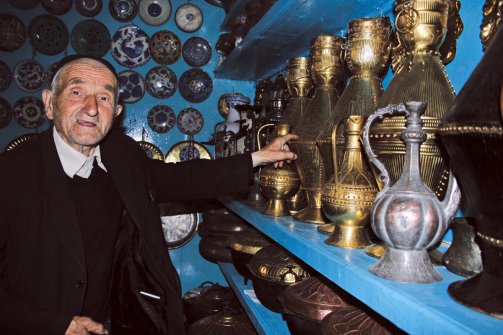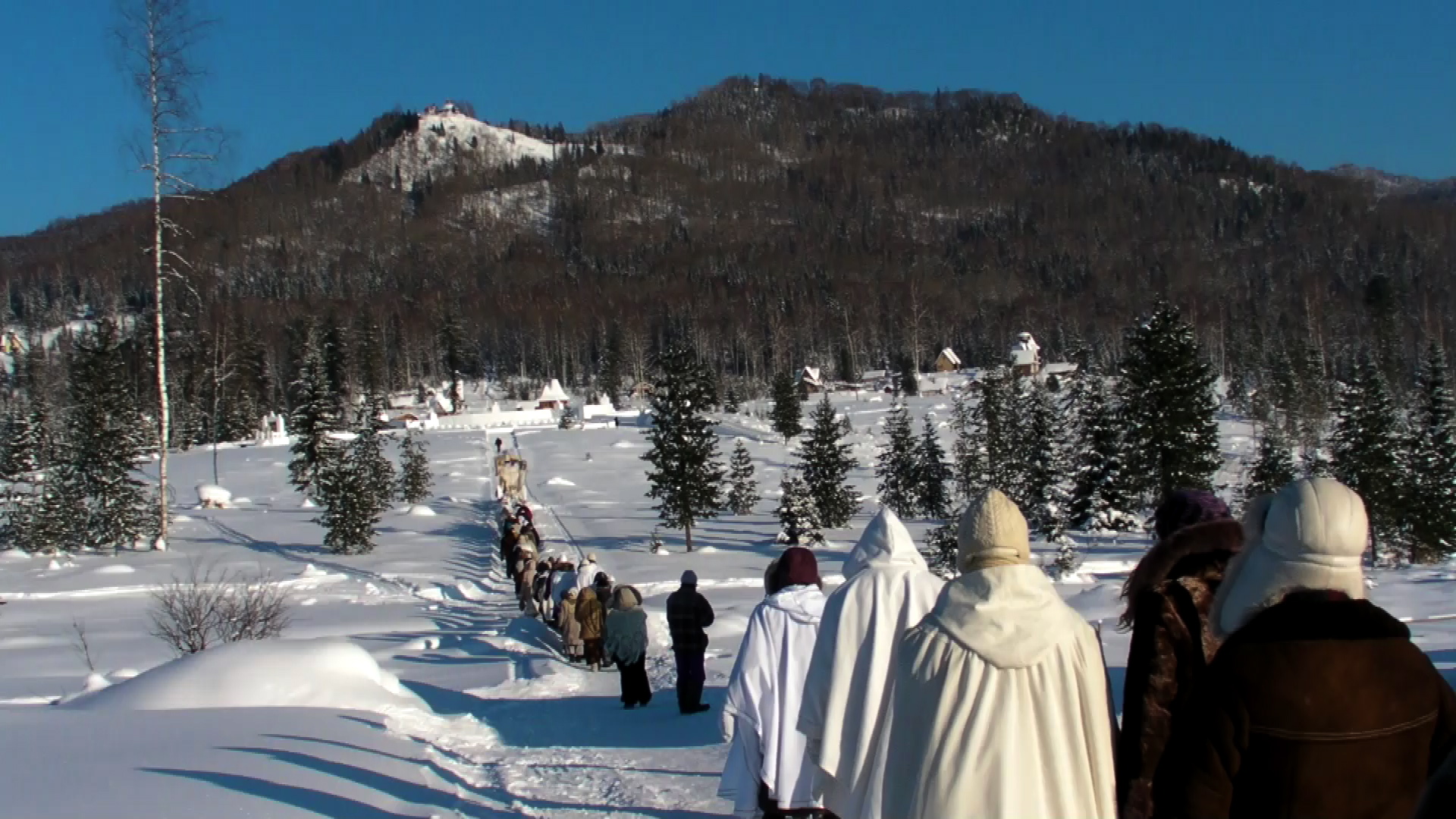
Early mornings begin with the pounding of hammers. A warm, seductive mix of aromas—smoky baked bread and sweet summer grass—floats over the Dagestani village of Kubachi, an enclave whose quiet, artistic air is all the more remarkable for being on the doorway of war. The rest of the troubled republic in Russia's south is torn by fighting between its Sufi majority and Salafi minority. But here in Kubachi, the chaos seems far away.
The town is populated by silversmiths who have been welding beautifully designed swords, graceful tall jugs, and sophisticated bracelets for centuries, passing the traditional secret skills from father to son. The graceful ornaments carved by Kubachi's modern-day silver masters are not much different from those decorating the knives Queen Victoria once received as a gift from Tsar Alexander III. While the men work in the smithies, the women of Kubachi drag out their stools onto the narrow streets, where they embroider delicate silk fabrics until the sun sets.
The tranquil pace of Kubachi's artisanal life makes it easy to forget about the frightening reality in the rest of Dagestan. Even from here one can see rising clouds of dust on a distant highway—heavy armored vehicles and military Ural trucks, loaded with ammunition and thousands of Russian soldiers, drive the roads of Dagestan day and night. The unending reinforcements that Moscow officials refer to as "rotations," and people in Dagestan as "invasion," represent an escalation of the region's two-decade-long conflict into something more like the long wars in neighboring Chechnya.
The troop increase began two weeks after Vladimir Putin's victory in the March presidential elections. The movements are not covered by Russia's mainstream media. Locals say that with suicide bombings on the rise in the region, along with the deaths of hundreds of local police officers and civilians (824 last year alone), Putin made a decision to intensify the fight in Dagestan. Since then, more than 17 Salafi Muslims disappeared in the course of recent "cleansing" operations by the government, according to human-rights defenders in the region.
But life in the Kubachi has so far remained peaceful. "The secret is simple: Kubachi is protected by muses," says Patimat Aliyeva, a daughter, wife, and mother of silversmiths.
For many places in the North Caucasus, traditional arts and crafts have been a barometer for the atmosphere of constant violence. Handicraft in the mountain villages was among the first things to disappear when Russian bombs began to fall on Chechnya in 1994. Famous for their handmade dresses and beautiful embroideries, Chechen women lost their interest in sewing and needlepointing for more than a decade as they sought to merely eke out survival in the refugee camps. Yet sewing has now reappeared in Chechnya under the region's wary peace.
In Kubachi, the preservation of prestigious art schools is becoming a particularly hard effort for the city. As far back as the 10th century, Arab historians praised Kubachi as the center for the most coveted handmade silver-inlaid weapons. But older silversmiths are dying off before they can teach their craft to a young generation of artisans. The silversmiths have also felt pressure from their main employer, a jewelry and souvenir manufacturer that once employed hundreds of Kubachi silver masters, but is now opting for a cheaper look found in many souvenir shops these days.
Despite this, the local silversmiths have remained devoted to their 1,000-year-old tradition. Almost every house in Kubachi—the village's name means "the place of chain-mail masters" in Turkish—contains a workshop, a treasury, and a private museum for storing the silverwork.
The oldest master in the village, Gadji Amar Izabakarov, turned 80 this year. Black-and-white portraits on the walls of his kitchen feature his parents, uncles, and aunts in traditional costumes—each of them famous for their handmade swords, bracelets, and embroideries. Smiling happily, Izabakarov turns the key in the heavy lock on the door to his home, which is also a museum. Round copper pots for cooking, tall silver water jugs and swords—some hundreds of years of old and worth untold fortunes—glisten in the sunlight. They are real treasures. The master's wrinkled hands lovingly pass over the ornaments covering tiny vodka shot glasses on delicate trays, some of his proudest pieces. At Kubachi's only school, Izabakarov teaches children of all grades to recognize the era and value of ornaments, and to use their knowledge of smithery to divine the age of ancient graves at the historical cemetery, or of the metal door on the old mosque. "Every time I visit a jewelry exhibit in Moscow or Dagestan's capital, I urge Russian bureaucrats to help save Kubachi," says the old jeweler. But he fears that too few Kubachi masters are left. The mountain village, he said, is "an inhabitant island" that must survive on its own.
As the sun goes down, young girls put on their traditional white head scarves and go to fetch water from a hilltop well. Their little caravan, with each girl carrying a 10-liter silver water jug on her shoulder, looks spectacular and surreal against the green Caucasus hills. It takes about six months for a woman to embroider a headscarf. They will most likely be sold locally in Kubachi, as the rest of Dagestan's girls prefer cheap Turkish or Egyptian hijabs. The most beautiful and expensive Kubachi headscarf is worth between $500 and $1,500—a light, airy fabric with gorgeous flowers all over it, the cloth covers most of the girls' bodies, flowing over their dresses. A headscarf is given as a wedding present and kept for life.
Two or three hundred years ago, Aliyeva's predecessors knew how to sew with real silver and gold threads. Now the women use artificial metallic threads in their embroidery. Whispering gentle words in her Dargin dialect, Aliyeva unrolls her headscarf collection, turning the gold, blue, silver, and bronze pages of time. Her 21-year-old son, Gadji, is at an age at which so many young men in the Caucasus mountains begin to fight. He is working on attaching a precious stone to the scabbard of a silver sword he made this week. "I love swords for their beauty," he says shyly, "not for the pain they can cause"—a sentiment rare in Dagestan these days.


